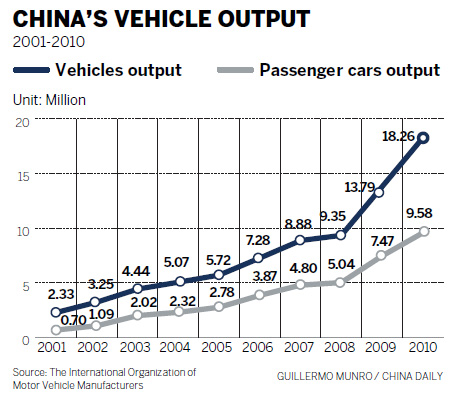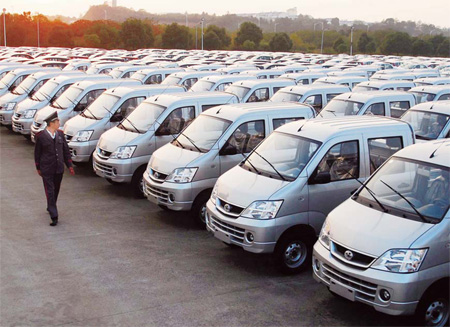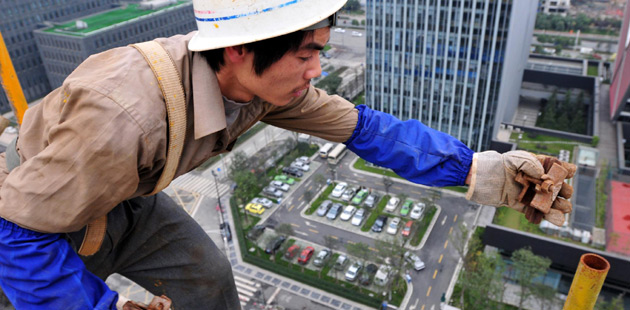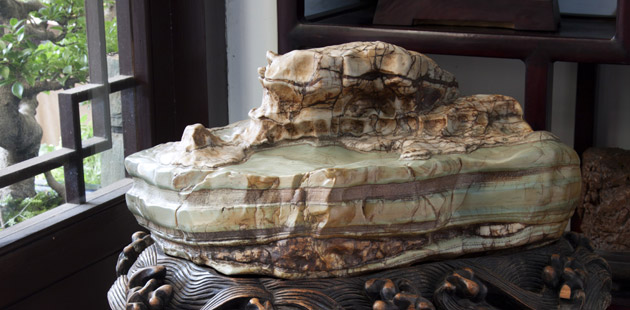Industry has powered forward
Updated: 2011-12-09 08:38
By Li Fangfang (China Daily)
|
|||||||||||
|
Minivans are ready to be shipped at a car factory in Nanchang, Jiangxi province. China has become the world's largest car maker and market. [Photo / China Daily] |
Ownership of cars has become a reality from an out-of-reach dream in 10 years
Xu Feng bought a Citroen Fukang sedan with a 1.6 liter engine before the Spring Festival in 2000. The car, priced at more than 120,000 yuan ($18,900) then, cost a large proportion of the private savings of 32-year-old Xu, who had started an electronics company in 1997 after resigning from a secure job as a school teacher.
"The champagne Fukang helped make me the star and successful elite among all my relatives and friends, and brought me confidence in being a businessman," Xu said.
The model, produced by the Dongfeng Peugeot-Citroen Automobile Group, a joint venture of the France's PSA Peugeot Citroen and Chinese manufacturer Dongfeng Group, stopped production in 2008. A used Fukang sells for no more than 30,000 yuan.
In 2006, Xu replaced his Fukang with an Audi A6; now he enjoys the comfort of sitting in a chauffeur-driven Mercedes-Benz S-Class.
"I also love to drive our Porsche Cayenne SUV with my wife during the weekend or on holidays," Xu said. "Last year we bought a Mini as our daughter's birthday gift. But for Beijing's quota policy, I'd like to add a sports car, either a Ferrari or a Porsche, in my garage.
"Ten years ago, I never imagined that one day, I would drive a Mercedes or Porsche. When I bought the Fukang, I thought it would be my transportation tool for at least 15 years."
Indeed, Xu's dream was fulfilled in part by China's entry into the World Trade Organization (WTO) which sharply cut tariffs, encouraged local cooperation and production, and lowered the average price of vehicles by 50 percent. It made the out-of-reach dream of owning a car a reality.
Increased demand exceeded supply. And nowadays, people even have to wait for long periods or pay extra to get popular models.
After China's entry to the WTO in 2001, the automotive industry came into a high-speed development period. Over these 10 years, annual sales volume of China's automotive industry boomed from 2 million to 18 million a year, which not only attracted more foreign automotive companies to invest, but also drove the growth of local automotive companies.
Since 2009, China has been the world's vehicles sales champion.
But the skyrocketing market has resulted in traffic jams, a serious problem in big cities such as Beijing and Shanghai, and even in second-tier cities.
Shanghai's license plate auction and Beijing's lucky draw for car purchases are controversial ways for the governments to control surging vehicle numbers.
However, looking back at the negotiations for China's entry into the WTO, the automobile industry was seen as "the most difficult part", Long Yongtu, China's chief negotiator for the entry of WTO, said. "Nobody foresaw it would turn out to be one of the most successful and prosperous industries, bringing huge changes and direct impact on an individual's life 10 year later."
The industry also has changed dramatically, Zhang Xiaoyu, vice-president of the China Machinery Industry Federation, said.
"The Chinese automotive industry was a fledgling sector during the WTO accession negotiation. Since China's entry into the WTO, the automotive sector has developed into a major industry and shifted the global auto market center," Zhang said.
"In the development of the global automotive industry in the 21st century, China will undoubtedly play a very important role."
Since 1979 when China started to allow foreign companies to establish joint ventures, the market has shown great potential which attracted many foreign marques to invest in China.
Zhang said the automobile industry was stagnant before 2000, in particular the 10 years before the country joined the WTO. Annual vehicle sales in that period grew slowly, from 1.2 million in 1992 to 2 million in 2000.
In 1998 and 1999, several auto manufacturers experienced huge losses amid a chilly market.
In 2000, the world's total vehicle production and sales reached 60 million units, mainly by automakers from the United States, Germany, Japan, France and Italy. By comparison, China's automobile industry was almost static.
There were also worries that joining the WTO would badly affect China's vehicle industry.
When China started to discuss the automobile industry with the WTO in 1997, the tariff of vehicles imported into China reached 180 to 220 percent. By 2005, the tariff was cut to 25 percent and the vehicle import quota was abolished.
Moreover, the government removed the policy on limiting foreign and private enterprises taking part in vehicle production.
Just a day before China's entry to the WTO, Zhejiang Geely Holding Group Co, the first private automaker, received approval to produce its first model, the Geely JL6360. Now the homegrown brand is known around the world through its acquisition of the century-old Swedish Volvo Car Corp in 2010.
More Chinese automakers, after selling their cars overseas, have started to establish production facilities outside China to further expand in the global market.
In 2000, China exported only 15,000 vehicles. The number surged to 560,000 in 2010, with a total revenue of $51.8 billion.
China's entry to the WTO also provided Chinese automotive players the opportunity to compete against well-established foreign rivals in the domestic and overseas markets.
China should therefore continue to support its automakers to further develop and make the country a powerful player over the next 10 years, Xu Changming, deputy director of the information resource department at the State Information Center, said.










